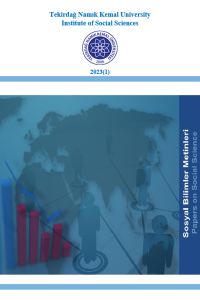Research Article
Aim & Scope
The journal aims to publish scientific studies that include interdisciplinary and comparative research, critical studies and alternative approaches in social sciences.
The Journal of Papers on Social Science is published twice a year (in April and October) and indexed in many national and international databases, especially EBSCO and ProQuest. It is a peer-reviewed international journal searched in many international and national databases. Papers on Social Science constitute a forum for reviewing and evaluating past and current studies, both theoretical and practical, preferably on Balkan geography.
Author Guidelines
PUBLISHING RULES
- Papers on Social Science is a peer-reviewed journal published twice a year in April and October. The journal supports interdisciplinary and comparative research, critical studies and alternative approaches in social sciences. Papers on Social Science constitute a forum for reviewing and evaluating theoretical and practical past and current studies, preferably on Balkan geography.
- Articles submitted to the journal for publication can be written in Turkish and English. The scientific and linguistic responsibility of the articles published in the journal belongs to the authors.
- The authors state their submitted articles have not been to the journal have not been previously published or electronically published anywhere, they are not currently recommended to any journal and/or are not in the process of evaluation; declare and accept that it does not interfere with someone else's copyrights, if it does, all responsibility belongs to the author(s) and that it does not contain any information or explanation contrary to the law and human rights. The responsibility of the articles to be published belongs to the authors and the content of the articles in no way binds Tekirdağ Namık Kemal University Institute of Social Sciences and Papers on Social Science.
- All articles must be submitted electronically through the Dergipark system. Author(s) must prepare their papers following journal publication rules and ethical rules. Articles not submitted by the rules will not be evaluated. Submitted papers mean that they have not been published elsewhere or submitted for publication.
- Articles submitted to the journal are sent to at least two referees by the decision of the Editorial Board. The Editorial Board may increase the number of referees or apply to the Advisory Board when necessary. After the corrections requested by the referees are corrected by the author(s) within 30 days and sent electronically together with the report on the modifications made, the article is taken back to the referee evaluation process. The articles submitted to the journal are published with the decision of the Editorial Board after receiving positive opinions from at least two separate referees.
- Manuscripts to be published in the journal must comply with spelling and grammar rules. Suppose the article is accepted for publication as a result of the peer review. In that case, the responsible author is deemed to have accepted that all publishing rights of the article belong to the Papers on Social Science indefinitely, on behalf of all authors, by filling out the "Copyright Agreement Form" showing the ranking of the authors.
- The form regarding the contributions of the authors and the absence of conflicts of interest must be completed and signed by all authors. Click here to access the relevant form.
- The author(s) can submit an article to the journal at any time or withdraw an article in progress. The articles whose evaluation process is completed are published considering the arrival date. Two articles by the same author(s) cannot be published simultaneously.
WRITING RULES
- Studies submitted for publication should not exceed 25 pages, including appendices and a bibliography. Manuscripts should be written in Word format using the "Times New Roman" character. The margins should be left 2.5 cm, right 2.5 cm, top 2.5 cm, bottom 2.5 cm in all work to be sent to the journal. Click for a sample draft file.
- Title: Turkish and English titles should be written in Times New Roman 12 points and bold, with all capital letters above the Turkish and English abstracts.
- Author name(s) and address(es): The author(s) of the article should write their name(s) and surname(s) centered under the Turkish title of the article in 12 font sizes. The institution/department, e-mail address and ORCID number/numbers, according to their academic title(s), should be written as a footnote in 10 font size on the first page. The responsible author should be indicated as a footnote on the first page.
- Abstract: On the first page of the manuscript, there should be a Turkish and English title, a Turkish and English summary not exceeding 150 words, and a maximum of 5 keywords under the abstracts. Abstracts should be written in single line spacing, 10 font size, and justified.
- Titles: Titles should be written in 12 font size bold, only the first letters of the words should be capitalized and justified. Subheadings should be written in 11 points in bold and only the first letters of the words should be capitalized. In heading numbers, the numbers should be given after the introduction and numbered in the decimal system (such as 1., 1.1., 1.1.1.).
- Main Text: Paragraphs should be 11 font size, alignment; justified, recess; left: 0 cm, right: 0 cm; special: The first line should be 1cm. Before and after the paragraphs, 6 pt spacing should be left and the line spacing should be single. Page numbers should not be given.
- Tables and Figures: Figure and table captions should be written on tables and figures in 11 font size bold; centered over tables and figures, each row number (Table 1, Table 2 and Figure 1, Figure 2, etc.) and reference notifications should be given under tables and figures in 10 font size and bibliographic information should be given completely. Table, figure, etc. The text inside should be 10 font size. Sequence numbers should be given to the mathematical equations to be included in the text, and the sequence numbers should be written in parentheses, justified to the right of the page.
- Citations: References should be made in the text using the conjunction method. Explanatory notes should be expressed in footnotes (10 points) at the bottom of the page. References in the text should be made as to the author's surname (s), year of the source and page number. If there is no author name, the institution name should be used instead of the author. Example; (Akdeniz, 2021), (Akdeniz et al., 2021, pp. 223-224), (Aydın, 2020, p. 236), (Demirkol & Açıkgöz, 2019, p. 63), (IMF, 2004, p. 32).
- References: The references should be arranged in 11 font sizes at the end of the study. The references should start from the page where the article ends, and the studies should be listed alphabetically by surname. When citing multiple papers by the same author, the publication date should start with the oldest. When citing more than one article of the same author with the same date, references should be numbered using the letters a, b, c, … in the bibliography and in-text citations. Sample; Like 2003a, 2003b, 2003c. Single-authored work should be specified first about a single or more than one author's paper.
Ethical Principles and Publication Policy
Price Policy
No fee is charged for article publication or article processes in the journal.
Papers on Social Science is an "open access" journal and published papers can be accessed for no fee.
Indexes
Journal Boards
Editor in Chief

Co-editors


Turkish Language Editor

English Language Editor
Economics and Business Administration Field Editor

 Web
Web
International Relations Field Editor

Labour Economics and Industrial Relations
History and Balkan Studies Field Editor

Political Science and Public Administration Field Editor

Psychology Field Editor

Theology Field Editor
Sociology Field Editor
Turkish Language and Literature Field Editor

Fine Arts Field Editor
Social Services Field Editor
Law Field Editor

German Language and Literature Field Editor

French Language and Literature Field Editor
English Language and Literature Field Editor
Layout Editor

 Web
Web











